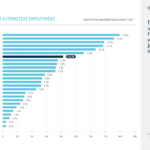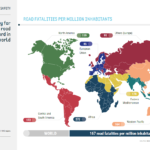There are three major economic growth theories: Classical economic theory, Neo-Classical theory and New-Growth Economics.
Classical theory states that the output of a country depends on the capital available per worker. If capital per worker increased output would increase. The problem with this theory is that it does not account for important factors like technological change and the stock of knowledge. There are many African countries where capital per worker has increased in recent years due to the discovery of natural resources such as diamonds and oil. Nigeria and Sierra Leone are examples of such countries. Though oil was discovered in Nigeria in 1956, in 1998 Nigeria ranked 151 of 174 countries assessed under the United Nations Development Program’s Human Development Index. The majority of the population has the lowest living standards in Africa. Similarly diamonds were discovered in Sierra Leone in 1930; however, the United Nations listed the country among the World’s Poorest Countries of 2003. Thus when we apply the Old Classical theory to these countries, it is proved incorrect (i.e. though the capital per worker increased the output did not increase). This is because even though the capital per workers increased, there were no technological innovations in these countries. Moreover the capital fled abroad to escape instability at home
The Neo Classical theory tries to address some of the problems with the original classical theory. It states that economic growth is dependent not only on capital and labor but also on technology. Robert Solow isolated the sources of economic growth using a growth accounting equation. His contribution is to explain the sources of long-term economic growth. One problem with Solow’s theory is that it does not explain the reasons for the difference in economic growth rates between countries. Solow predicted that there would be convergence in the standard of living of all the countries of the world. This is because the growth in developed countries would stagnate because of the diminishing return to capital per worker and capital would flow to developing countries where there would be higher rates of return. Invested capital would in turn, lead to convergence between the developed, underdeveloped and undeveloped countries. However, in practice, the convergence predicted by Solow has not happened because growth in advanced countries continues to increase due to technical progress and also the capital does not flow to underdeveloped and undeveloped countries because of factors such as political instability and lack of institutional reforms. Conditional convergence occurs among countries with similar economies and cultures but not among dissimilar economies. Hence we find that both the classical and neoclassical growth theories do not adequately explain the differences in growth between various countries. The theories do not consider the fact that the wealthy and developed countries can improve upon their existing knowledge base and maintain the lead over the other countries due to technological innovation.
The New Growth Economics proposed by Paul Romer and Robert Lucas provides an explanation for the persistence of long run inter-country growth differences. These two economists from the University of Chicago proposed the theory in the 1980s. According to this theory, technology is endogenous (i.e. produced from within) and economic growth occurs from innovations that result from new ideas. New ideas come from many economic agents. These economic agents can be either privately or publicly funded. Some examples of the economic agents are the R&D department of a big corporation or a government funded entity such as NASA. These agents create new ideas from the pool of knowledge. The New Growth Economics can be represented as Y = f (K, L, H, A) where K is physical capital, L is labor, H is human capital, A is technological change and Y is output. The old classical theory concentrated on capital available for a country’s economic growth. Solow emphasized the importance of technical innovation for long-term growth, but his work did not account for the causes of technical change. Romer and Lucas, on the other hand, identified the causes of technological change in their New Growth Economics theory.
In addition to putting emphasis on technical change, New Growth Economics also proposed public policies supportive of economic growth. The public policies are listed in below:
- Free Markets
- Intellectual Property (IP) Laws and Enforcement
- Support of R&D (due to knowledge Spillover)
- Human capital
- Rule of Law
- Need for Openness (free flow of ideas, people)
- Democracy
- Political Stability
- Government Spending (productive spending)
- Concentration on Technical Innovation like IT
Source: Applied MacroEconomics – Olivier Blanchard
In order for innovations to flourish, Lucas and Romer state that a free market form of government is essential. The US economy is a perfect example of their theory, where free market capitalism generates the majority of the technical inventions and hence higher economic growth. Every major business cycle in the US economy has been made possible by new innovations. Examples of this include the dynamo, railroad, microprocessor, computer, Internet, etc.
Are we following the public policies of New Growth Economics?
1. Free Markets – While the core of the free market principles are still followed some of the recent actions by the government such as the bailouts have prompted some folks to question if we are moving away from free market principles. In fact, there are some folks who say that things such as Social Security should not exist in an ideal free market. However I do believe that compared to most other countries the USA still has the best free market system in the world.
2. Intellectual Property (IP) Laws and Enforcement – The IP laws and their enforcement in this country are no doubt the best anywhere. For example, copying and distribution of music, movies, etc. are illegal and violators are taken to court by the IP owners. Similar rules are applied to companies for patents.
3.Support of R&D (due to knowledge Spillover) – The government and the private sector spend huge amount of their budgets each year on Research and Development. However it must be stated that some countries such as China are investing heavily in R&D to catch with the advanced countries. Knowledge Spillover occurs when a company files a patent. When other companies come to know of the patent they try to create better ideas.
4. Human capital – Some of the best and brightest minds in many fields live in our country. We continue to attract the best talent in the world.
5.Rule of Law – This is a country built on law and most of us follow the laws.
6.Need for Openness (free flow of ideas, people) – We encourage free thinking, free flow of ideas and we accept people from around the world no matter what their belief systems are.
7.Democracy – For a young nation, we have a highly successful democratic political system.
8.Political Stability – Compared to many other countries, political stability is not an issue in our country. For example in many emerging market countries such as India, Brazil, Chile political stability may not exist.
9.Government Spending (productive spending) – This public policy suggests that government spend its funds on productive projects. But what exactly does productive spending mean in modern times? Some may say even investments in infrastructure such as roads is not productive spending since it does not generate any additional return to the government.
10.Concentration on Technical Innovation like IT – Innovation can be one of the engines for growth. A few weeks ago Business Week had a cover story on how innovation is important for companies even when economy is in recession.
Questions to readers:
1. Should we follow all the public policies of New Growth Economic Theory to pull us out of the current mess?
2. Will New Growth Economics lead us out of this downturn?
3. Instead of encouraging bailing out banks and encouraging them to lend should the government increase its spending ?
4. Do we need to invest more in R&D and develop new products that we can export to other countries?
5. If we emphasize technical innovation as suggested by New Growth Economics or concentrate more on manufacturing and other high labor intensive industries?
Feel free to leave your answers in the comments section.



